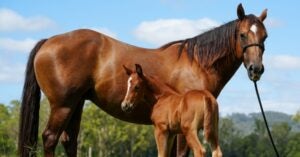Cribbing activity in horses has been showed to go back as far as the 1800s. Research and understanding of the activity has evolved a lot since then but there is still a lot to learn. As a horse community we are still trying to fully understand this equine stereotype.
Cribbing is an act that a horse does by biting down with its incisor teeth on a wood surface while arching its neck and sucking in air. Unfortunately, there is no definitive cure for cribbing. While it is an annoying act that every owner would like to defeat, it’s best to keep the mindset that you won’t cure it. But by looking into the possible underlying reasons of why your horse cribs, maybe you can find some helpful management practices that give your horse more ease and decreases cribbing in the process.
1. Keeping Your Horse Active
Cribbing could be caused by boredom or anxiety. One way to discourage your horse from cribbing is by keeping them turned out to pasture as much as possible. Horses are range animals that aren’t meant to be kept in stalls all of the time. This may not always be practical if you live in an area that has extreme winters, or if the current living situation for your horse doesn’t provide adequate pasture access, but aiming for maximized turnout time is important. If your horse is confined to a stall, there are stall toys, such as Jolly Balls or Pas-A-Fiers that can provide entertainment and distractions from cribbing by providing them with alternative oral stimulation.
Horses are also herd animals, meaning that they feel most comfortable with companionship. Turning them out with other horses can decrease their anxiety by giving them friends and a sense of a herd community. If you can’t turn them out with other horses, consider other livestock, such as a goat, for a comparable companion. Lastly, giving your horse a job is a good way to keep them stimulated elsewhere and gives them less time to crib. A moderate work load decreases boredom and expends energy in a healthy way.
2. Changing Your Horse’s Diet
Giving your horse free access to hay helps to keep their mouth occupied. Further, enriching their experience with hay can help distract them from boredom. Putting the hay in a slow feeder makes forage last longer, and placing it in multiple spots around their paddock makes the horse move around more. If your horse doesn’t have a high-performance job, you may consider reducing or taking your horse off grain completely. If your horse still needs grain supplementation, consider grain lower in sugar and starches and higher in fat and fiber. Research has shown a correlation between cribbing and higher sugar diets.
While horses that crib can have stomach ulcers, research doesn’t show a direct cause between cribbing and ulcers. However, if you are treating your horse for potential underlying stress, consider feeding alfalfa hay. Alfalfa is high in calcium and helps buffer stomach acid. It may also be helpful to get the sugar-content of your hay analyzed. Being aware of exactly what you’re feeding your horse may provide insight into your horse’s energy levels and gut health.

3. Cribbing collars
Putting a cribbing collar on your horse is another solution to cribbing, however it is a temporary solution. Cribbing collars are strapped around the horse’s throatlatch and are made of stiff leather or metal and serve as a type of self-punishment. As the horse arches their neck to inhale air, the collar brings discomfort to the throatlatch and causes the horse to retract their head. Cribbing collars are a temporary solution because they only work while the horses wear them. The collar also must be effectively tight around their neck, which could rub sores if the collar isn’t frequently checked. Horses can also find ways to dislodge the collar enough so that the punishing part of the collar is moved from their throatlatch, allowing them to crib with the collar on without punishment or with lesser punishment.
4. Acceptance and Management
In some cases, accepting the cribbing behavior may be the best action for the welfare of the horse. Implementing all the other management practices still might leave you with a cribbing horse. Trying to completely eliminate cribbing may be too stressful on the horse, so creating a safer way for your horse to crib could be the better answer. Covering a wood surface with rubber and encouraging positive reinforcement to crib on the rubber surface could help eliminate destruction of other wood surfaces and would also help protect your horse’s teeth. The destruction of wood surfaces is a nuisance to cribbing horse owners. Painting anti-chew spray over wood or covering wood surfaces with metal are other solutions to extending the life of wood and may also discourage your cribbing horse from protected surfaces. Another alternative is giving your horse the freedom to crib for part of the day and using a cribbing muzzle for the rest of the day.
Boredom, stress, anxiety, and stomach ulcers are some of the underlying reasons why your horse may crib. However, it is also proven that a cribbing horse can be free from all of these problems and still crib without obvious reason. By eliminating these possible causes, you narrow down what best way to manage this habit. Remember that you likely will never stop a cribbing horse from cribbing, but you may find a way to reduce the behavior.
Rebecca Sherwood is Kentucky-born and Texas-raised and has worked as an editor for the USDA. She earned her degree in animal science from Texas A&M University.



